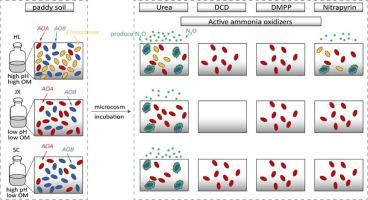Our official English website, www.x-mol.net, welcomes your feedback! (Note: you will need to create a separate account there.)
Effects of commonly used nitrification inhibitors—dicyandiamide (DCD), 3,4-dimethylpyrazole phosphate (DMPP), and nitrapyrin—on soil nitrogen dynamics and nitrifiers in three typical paddy soils
Geoderma ( IF 6.1 ) Pub Date : 2020-12-01 , DOI: 10.1016/j.geoderma.2020.114637 Xue Zhou , Shuwei Wang , Shutan Ma , Xinkun Zheng , Zhiyuan Wang , Chunhui Lu
Geoderma ( IF 6.1 ) Pub Date : 2020-12-01 , DOI: 10.1016/j.geoderma.2020.114637 Xue Zhou , Shuwei Wang , Shutan Ma , Xinkun Zheng , Zhiyuan Wang , Chunhui Lu

|
Abstract The use of nitrification inhibitors (NIs) with ammonium (NH4+) -based fertilizers is an efficient strategy for reducing nitrogen (N) loss by affecting ammonia-oxidizing archaea (AOA) and ammonia-oxidizing bacteria (AOB) in agricultural soils. The inhibition mechanisms of NIs on AOA and AOB are still debated, as some studies have demonstrated that NIs inhibited functionally dominant groups, while others have reported selective inhibition of AOB rather than AOA. Here, we identified the impacts of the most commonly used NIs (dicyandiamide (DCD), 3,4-dimethylpyrazole phosphate (DMPP) and nitrapyrin) on the nitrification activity, N2O emission, and abundance and metabolic activity of ammonia oxidizers (AOA, AOB, and comammox (detected only in HL)) in three paddy soils (HL, JX, and SC) with distinct properties using microcosm incubation combined with the 13CO2-DNA-stable isotope probing (SIP) technique. Most of the NIs treatments effectively inhibited the N2O emission with efficacy suppressed the metabolic activity of AOB, regardless of soil type and NI type, whereas the nitrification process and AOA activity could not be inhibited. The efficacy of NIs was also dependent on soil chemical properties, as nitrapyrin did not inhibit AOB growth at the beginning of microcosm incubation in HL, and DCD successfully inhibited the activity of both AOA and AOB in JX. In HL, DCD and DMPP effectively inhibited the activity of comammox, while nitrapyrin could not inhibit its activity. This study is the first to identify the response pattern of comammox to DCD, DMPP, and nitrapyrin in paddy soil by DNA-SIP microcosm incubation. This study also suggested that NIs might selectively inhibit AOB rather than AOA.
中文翻译:

常用硝化抑制剂双氰胺(DCD)、3,4-二甲基吡唑磷酸盐(DMPP)和硝基吡喃对三种典型稻田土壤氮动态和硝化作用的影响
摘要 硝化抑制剂 (NI) 与铵 (NH4+) 基肥料一起使用是通过影响农业土壤中的氨氧化古菌 (AOA) 和氨氧化细菌 (AOB) 来减少氮 (N) 损失的有效策略。NIs 对 AOA 和 AOB 的抑制机制仍然存在争议,因为一些研究表明 NIs 抑制功能优势组,而其他研究报告选择性抑制 AOB 而不是 AOA。在这里,我们确定了最常用的 NIs(双氰胺 (DCD)、3,4-二甲基吡唑磷酸盐 (DMPP) 和硝基吡啶)对氨氧化剂(AOA、AOB)的硝化活性、N2O 排放以及丰度和代谢活性的影响和 comammox(仅在 HL 中检测到))在三种水稻土(HL、JX、和 SC) 使用微观孵化结合 13CO2-DNA 稳定同位素探测 (SIP) 技术,具有不同的特性。无论土壤类型和 NI 类型如何,大多数 NIs 处理都能有效抑制 N2O 排放,抑制 AOB 的代谢活性,而不能抑制硝化过程和 AOA 活性。NIs 的功效还取决于土壤化学性质,因为在 HL 中的微观孵化开始时,硝基吡啶不抑制 AOB 的生长,而 DCD 成功地抑制了 JX 中 AOA 和 AOB 的活性。在HL中,DCD和DMPP有效抑制了comammox的活性,而硝普林不能抑制其活性。本研究首次通过 DNA-SIP 微观孵化确定了 comammox 对稻田中 DCD、DMPP 和硝基吡啶的反应模式。
更新日期:2020-12-01
中文翻译:

常用硝化抑制剂双氰胺(DCD)、3,4-二甲基吡唑磷酸盐(DMPP)和硝基吡喃对三种典型稻田土壤氮动态和硝化作用的影响
摘要 硝化抑制剂 (NI) 与铵 (NH4+) 基肥料一起使用是通过影响农业土壤中的氨氧化古菌 (AOA) 和氨氧化细菌 (AOB) 来减少氮 (N) 损失的有效策略。NIs 对 AOA 和 AOB 的抑制机制仍然存在争议,因为一些研究表明 NIs 抑制功能优势组,而其他研究报告选择性抑制 AOB 而不是 AOA。在这里,我们确定了最常用的 NIs(双氰胺 (DCD)、3,4-二甲基吡唑磷酸盐 (DMPP) 和硝基吡啶)对氨氧化剂(AOA、AOB)的硝化活性、N2O 排放以及丰度和代谢活性的影响和 comammox(仅在 HL 中检测到))在三种水稻土(HL、JX、和 SC) 使用微观孵化结合 13CO2-DNA 稳定同位素探测 (SIP) 技术,具有不同的特性。无论土壤类型和 NI 类型如何,大多数 NIs 处理都能有效抑制 N2O 排放,抑制 AOB 的代谢活性,而不能抑制硝化过程和 AOA 活性。NIs 的功效还取决于土壤化学性质,因为在 HL 中的微观孵化开始时,硝基吡啶不抑制 AOB 的生长,而 DCD 成功地抑制了 JX 中 AOA 和 AOB 的活性。在HL中,DCD和DMPP有效抑制了comammox的活性,而硝普林不能抑制其活性。本研究首次通过 DNA-SIP 微观孵化确定了 comammox 对稻田中 DCD、DMPP 和硝基吡啶的反应模式。

























 京公网安备 11010802027423号
京公网安备 11010802027423号